Oldbury Benefice

The Oldbury Benefice
The Oldbury Benefice is part of the Ramsbury group of parishes in the Diocese of Salisbury.
 The five parishes that form The Oldbury Benefice have histories which individually stretch back to the fourteenth century and maybe beyond that. The parishes of the benefice were first linked on 25th March 1835 together with Blackland, Bowood and Brehmhill under the Calne Poor Law Union when the joint population numbered 8,973.
The five parishes that form The Oldbury Benefice have histories which individually stretch back to the fourteenth century and maybe beyond that. The parishes of the benefice were first linked on 25th March 1835 together with Blackland, Bowood and Brehmhill under the Calne Poor Law Union when the joint population numbered 8,973. English Poor Law was the precursor to the modern day state benefit system and was administered by Poor Law Unions, partly elected and partly appointed such as local JP's, to help the elderly, widows, children, the sick, the disabled, the unemployed and the under-employed. This system was abolished in 1930, but the benefice as we now know it, didn't form until 1973
English Poor Law was the precursor to the modern day state benefit system and was administered by Poor Law Unions, partly elected and partly appointed such as local JP's, to help the elderly, widows, children, the sick, the disabled, the unemployed and the under-employed. This system was abolished in 1930, but the benefice as we now know it, didn't form until 1973 The Benefice is served by the Rector, a Retired Priest, a Lay Minister, a churchwarden for each of the five parishes and now we have eleven Lay Pastoral Assistants. Please see the page for the Benefice team for details of who they are.
The Benefice is served by the Rector, a Retired Priest, a Lay Minister, a churchwarden for each of the five parishes and now we have eleven Lay Pastoral Assistants. Please see the page for the Benefice team for details of who they are.
Parish records
For those of you who have an interest in your family or village history and wish to examine the parish records. They are now held electronically by The National Archives and have, or are about to be put on-line. Please search their records here.
The Benefice Gallery
We are blessed within our benefice with some of the prettiest churches around. Each one with its own unique history and eyecatching architectural beauty. We are compiling a gallery of some images of each church and more will be added as we go. Please view the galleries through the You tube links below and if you have some pictures that you think will show off the churches well, please do get in touch.
The Parishes
Below you will find a brief description of the parishes and a photo portfolio of images which we hope you will enjoy. You can scroll down or navigate between each section using the menu above.
Start your journeyCalstone
 The name Calstone is thought to represent Calne East Tun, meaning that it was colonised from Calne. Calstone was likely to have been part of the large royal estate of Calne back in the 10th century but by the time the Normans invaded in 1066 most of the estate had been granted away from the Crown as a series of smaller estates. In about 1600, the small manor of Calstone was given the name Calstone Wellington, the 'Wellington' represents the family name of the Lords of the manor during the 13th and 14th centuries and were grantees of Devizes Castle.
The name Calstone is thought to represent Calne East Tun, meaning that it was colonised from Calne. Calstone was likely to have been part of the large royal estate of Calne back in the 10th century but by the time the Normans invaded in 1066 most of the estate had been granted away from the Crown as a series of smaller estates. In about 1600, the small manor of Calstone was given the name Calstone Wellington, the 'Wellington' represents the family name of the Lords of the manor during the 13th and 14th centuries and were grantees of Devizes Castle.
The Church
There was a church in Calstone as early as 1301 but the present day St Mary's church was rebuilt in the 15th century of stone rubble and ashlar. The timber roofs of the porch and nave also date from the same period. A west gallery was added in the 18th century and in 1884 - 1885 the church was extensively restored with the vestry being added at that time and the narrow windows of the nave and chancel being replaced with much larger ones. The gallery was also removed during this process.
Please take a tour round this most pictureseque of churches by clicking on the You Tube link below.
Find St Mary's
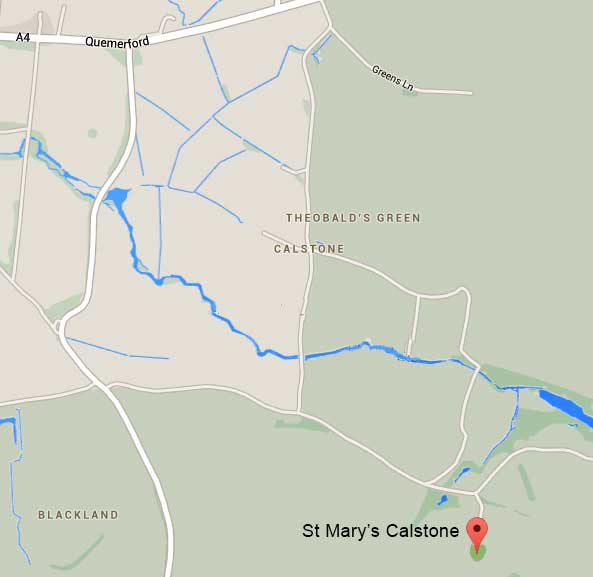
Cherhill
 The name Cherhill is thought to be drived from two seperate words, the chalk fertile uplands were known as 'eal' and the 'Cher' is widely believed to be the stream running through the village which joins the Marden at Quemerford. In recent years there have been several Roman artefacts found around the village pointing to the possibility of there being a Roman villa or other building of some importance nearby, although I am unaware of the discovery of the site of the building.
The name Cherhill is thought to be drived from two seperate words, the chalk fertile uplands were known as 'eal' and the 'Cher' is widely believed to be the stream running through the village which joins the Marden at Quemerford. In recent years there have been several Roman artefacts found around the village pointing to the possibility of there being a Roman villa or other building of some importance nearby, although I am unaware of the discovery of the site of the building.
The Church
All Saints church was built in the 13th century although parts of a 12th century door could put it as early as the previous century. A south porch and the bell tower were added in the 15th century. The church was built on Westcourt Manor and had connections to Kington St Michael priory. It was built of chalk block and free stone and consisted of the chancel and vestry, naive and aisles. In 1854 the church was renovated and the gallery was removed during these renovations. The bell tower originally held three bells although the tenor and treble bells were removed and replaced in 1636 and the remaing one was recast at some time during the late 17th or early 18th century. In the late 18th century a fourth bell was added and the fifth was added in 1931.
In 1951 the parishes of Cherhill and Yatesbury were joined under the same Rector until 1972 before becoming part of the Benefice in 1973.
Please take a tour round this most pictureseque of churches by clicking on the You Tube link below.
Find St James

Compton Bassett
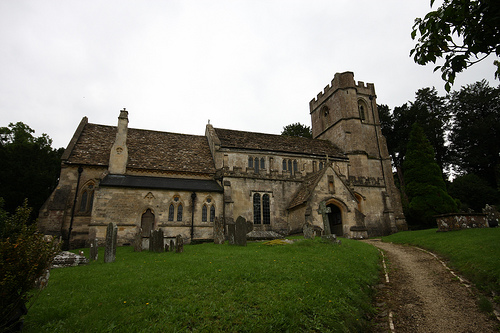 Introducing St Swithin's
Introducing St Swithin's
Bassett Parochial Church Council
The Church Visitor's book is a record of those seeking solace in times of grief and sadness, memories of family and friends and the observations of visitors inspired by the building itself. With accounts of alien abductions and police checks, all life is there!
A place of worship has been sited on the hill overlooking our village for at least one thousand years. Many Anglo Saxon Churches were built on pre-Christian sites of religious signifcance. We know St Swithin's has been part of village life since the end of the 11th century. To this day it continues to be a place of regular worship and pilgrimage, as well as holding special services for weddings, christenings and funerals. The graveyard has been a tranquil resting place for many centuries.
The Past and Present
When it was built, St Swithin's would have been at the centre or village life, with perhaps a Sunday livestock market in the churchyard. The walls would have been plastered inside and out, with vividly painted inner walls. There were no pews! Pulpits and pews were installed in most churches during the Tudor period, when sermons lasting as long as 4 hours became fashionable.
Today St Swithin's remains as an architectural monument (Grade 1 listed) and record of our community's history and development. Like so many churches it has been rebuilt. repaired and adapted and reflects the centuries during which it has stood
Notable features include
- A 15th century ornately carved Rood Screen depicting the twelve apostles
- Remains of the original medieval decorative wall painting
- Six church bells, the earliest dating from 1420
ST. SWITHIN'S chuch, so called in 1763, was built of rubble and freestone and has an aisled chancel with a north vestry, an aisled and clerestoried nave with north porch, and a west tower. Of the 12th-century nave, part of the west wall survives. The north aisle was added to the nave in the late 12th century, the south aisle in the early 13th; the chancel, partly rebuilt in the early 13th century, remained small. The walls of the aisles were rebuilt, probably on their original lines, in the 15th century; that of the south aisle may have been rebuilt again in the 18th. Also in the 15th century the tower and the clerestory were built, the chancel arch was enlarged, and an ornate stone screen with rood loft and integrated pulpit was erected. A medieval north porch was rebuilt apparently in the 18th century and again in the later 19th. In 1865-6 the chancel aisles and vestry were replaced by one designed by Henry Woodyer. Three bells were hung in the church in 1553 including one believed to have been cast by John Walgrave around 1420. Further bells were added in around 1620 by the Purdue family and the ring was increased to six in 1983 by the addition of a bell cast in the same year by John Taylor & Co from Loughborough. In 1983 the rectory was united to the benefice of Oldbury to form a new Oldbury benefice.
 St Swithin
St Swithin
A former Bishop of Winchester born in 800 AD, St Swithin was renowned for his charitable deeds and commitment to building churches. Before his death in 862 AD, he requested a simple grave outside the cathedral, exposed to the footsteps of the people and the rain. His remains were moved and buried in a tomb inside the cathedral a century later. The terrible storm that ensued was thought to be the expression of his displeasure and the origin of the St Swithin's Day superstition.
 Which came first, St. Swithin's or the Cathedral?
Which came first, St. Swithin's or the Cathedral?
Palaeography (ancient writing) has recently been discovered in Salisbury Cathedral behind a 1660 memorial, it is believed that it could be the earliest known example of written English in a Church and it is thought to predate the Reformation. At that time scholars had their heads chopped off if they dared to translate the Bible into English.
We at St. Swithin's know a little of how exciting the find must have been at the Cathedral because in February 2004, after extensive restoration, plaster fell off the wall of the north aisle and revealed floral patterns in red ochre which experts date as fifteenth century. The design seems as fresh as when they were first applied to the wall with confident flowing brush strokes by some long forgotten Banksy, of perhaps by a group of travelling church decorators.
It would be interesting to know which came first, St. Swithin's or the Cathedral???
The Registers
Registers of marriages and of burials survive from 1558 and of baptisms from 1563. All of which are complete.
Church Revenues
Compton Bassett church was standing in the late 12th century and it was given then to Bicester priory, which received an income from it until the Dissolution. Inhabitants of Compton Bassett may have been buried at Calne before Compton Bassett church was built, and a claim to oblations on the burial of parishioners of Compton Bassett was only given up by the owner of the revenues of Calne church in 1228. Presumably because Bicester priory took some of the church's revenues, the rectory was among the poorer livings of the Avebury deanery in 1291, when it was valued at £5. But by 1830 the rectory was valued at £497 and had become one of the wealthier livings in the diocese. The rector's income was then drawn from the tithes of up to 2,500 acres of the parish. The rectory house was said to be in a poor state of repair in 1783 and in 1842 a large new house, incorporating part of the old, was built of stone in a 16th century style. It was sold into private ownership in 1968.
Non-Conformity
In 1680 William Weld, the lord of Compton Bassett manor, was a papist. The rector was ejected for nonconformity in 1662, and in 1676 there were 21 protestant nonconformists in Compton Bassett. Most were probably members of the two Quaker families recorded in the parish between 1660 and 1675; another Quaker who lived in Compton Bassett died in 1777. By 1783 there was said to be no dissenters in the parish. In 1823 a meeting house was licensed for Independent Methodists, in 1834 another meeting house was licensed, and in 1838 a further one was licensed for Primitive Methodists. By 1864 there were no places of worship in the parish for nonconformists.

Heddington
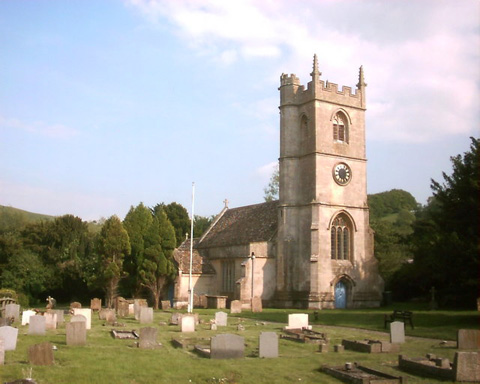 Heddington parish adjoins that of Calne Without and is approx three miles south of Calne. The parish boundary on the north side follows the Roman road from London to Bath and along the south side it follows, at least in part, the old London to Bath coach road which split from the London to Bristol coach road at Beckhampton, in use until the 18th century. The west end of the village was part of Chippenham forest until 1330 and was part of the large royal Calne estate until about the time of the Norman invasion in 1066. In the middle ages the village had a church, a rectory house and two larger farmsteads and several smaller ones within the parish boundaries. Today it is host to the Heddington Stockley Steam Fair annually.
Heddington parish adjoins that of Calne Without and is approx three miles south of Calne. The parish boundary on the north side follows the Roman road from London to Bath and along the south side it follows, at least in part, the old London to Bath coach road which split from the London to Bristol coach road at Beckhampton, in use until the 18th century. The west end of the village was part of Chippenham forest until 1330 and was part of the large royal Calne estate until about the time of the Norman invasion in 1066. In the middle ages the village had a church, a rectory house and two larger farmsteads and several smaller ones within the parish boundaries. Today it is host to the Heddington Stockley Steam Fair annually.
The Church
St Andrew's church is first mentioned in 1130 when it was given to Farliegh priory. The advowson belonged to the priory then until 1536 when it passed to the Crown on the dissolution of the priory. The church was rebuilt in the 13th sentury and the double chamfered arches and circular piers of the south arcade were added. The north aisle, which has an arcade with octagonal piers was added in the 14th century and the tower and porch were added in the 15th century. The church was dedicated to St Andrew in 1491. The church was greatly altered in the 17th century adding bigger windows and altering and enlarging the chancel arch. The church had much silverware although some was confiscated in 1553 but a burglary in 1973 meant that silverware dating back to the early 1700's was lost. Futher silverware was sold in 1976 to pay for the re-roofing in that year. There are six bells hanging in the tower and the earliest dates back to 1553. The five there at the time were re-hung in 1939 and the sixth was added in 1953.
Find St Andrews
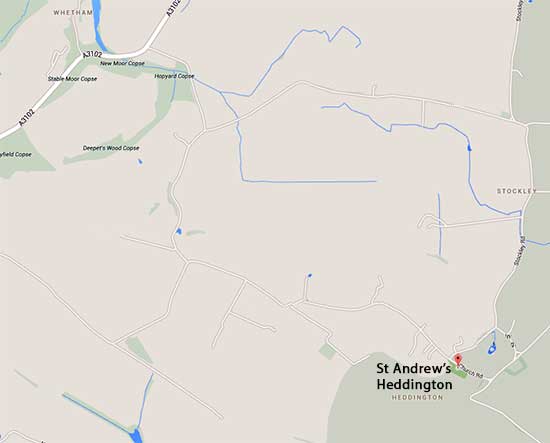
Yatesbury
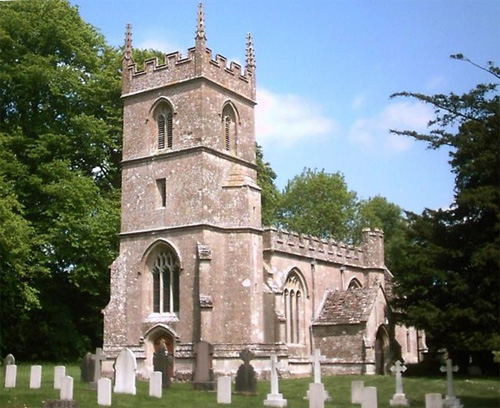 Yatesbury is the highest parish in the Benefice at 210m above sea level and has probably been the site of human habitation since the Romano-British times and a bronze age earthworks has been found in the southern corner of the parish, possible a cursus. In the 9th century Yatesbury was believed to have been held by the king and formed part of the royal estate but by the 11th century it is likely that Yatesbury belonged to Calne church. It is believed that in the early middle ages most of the demesne split away from Yatesbury manor and became two manors, each with their own buildings, one east of the village and one to the west. The western manor was known as Westcourt and Yatesbury Manor probably stands on the site of it's principal farmstead. Yatesbury airfield was in use during the first Wold War and again in1936. In about 1938 a large hutted RAF camp was built on the Cherhill - Yatesbury boundaryto the south east of the airfiled and a signals school was built south west of Windmill Hill. The station was closed in 1964 and by 1969 the buildings of the camp had been removed and by 1972 Wiltshire Council had restored most of the land back to agricultural use.
Yatesbury is the highest parish in the Benefice at 210m above sea level and has probably been the site of human habitation since the Romano-British times and a bronze age earthworks has been found in the southern corner of the parish, possible a cursus. In the 9th century Yatesbury was believed to have been held by the king and formed part of the royal estate but by the 11th century it is likely that Yatesbury belonged to Calne church. It is believed that in the early middle ages most of the demesne split away from Yatesbury manor and became two manors, each with their own buildings, one east of the village and one to the west. The western manor was known as Westcourt and Yatesbury Manor probably stands on the site of it's principal farmstead. Yatesbury airfield was in use during the first Wold War and again in1936. In about 1938 a large hutted RAF camp was built on the Cherhill - Yatesbury boundaryto the south east of the airfiled and a signals school was built south west of Windmill Hill. The station was closed in 1964 and by 1969 the buildings of the camp had been removed and by 1972 Wiltshire Council had restored most of the land back to agricultural use.
Yatecbury church was standing in the 13th century and may even date back as far as the 12th century. It was served by a rector in the 13th century and remained a rectory until the formation of the Benefice in 1973. In 1305 the church was also served by a vicar although no reference of a vicar in the parish can be found after 1362. The church appears to have been named All Saints in 1763. The animal head stops in the recessed door way are 12th century and are the oldest masonary in the church. The present nave with north and south aisles was built in 14th century. In the 15th century the south aisle was demolished and just the central bay of the arcade was spared. The doorway bearing the 12th century stops was set into this remaining bay. The tower was also built at this time. In 1854 the church was restored and the chancel, which by then had a ceiling was rebuilt with the vestry and in a 14th century style the chancel arch was enlarged and the whole church was repaired and refitted. Three bells were hung in the tower in 1553, in 1773 a further one was cast and hung and the fifth was added in 1931.
In 1951 the parishes of Cherhill and Yatesbury were joined under the same Rector until 1972 before becoming part of the Benefice in 1973.
Please take a tour round this most pictureseque of churches by clicking on the You Tube link below.